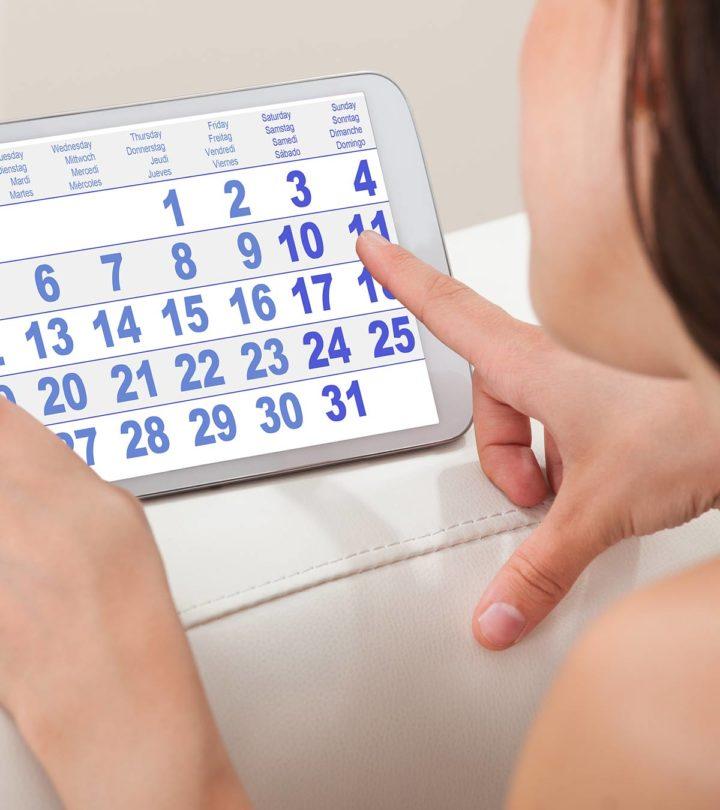How To Have Sex And Not Get Pregnant

Image: Shutterstock
Knowing how to calculate the safe period or infertile phase might help you figure out when to have sex to avoid pregnancy. Sex during the safe period is a natural contraceptive, but it is effective only when you understand your menstrual cycle and accurately calculate the safe and unsafe days.
That said, there is no guarantee that having sex only during the safe period will prevent pregnancy, as the woman's period cycle may change, and a miscalculation could lead to accidental pregnancies.
In this MomJunction post, we give you an idea of how the safe period can be calculated and the methods you may try for it. However, the use of contraceptives, even when you have sex during the safe period, is more effective in reducing the odds of pregnancy.
What Is The Safe Period For Having Sex?
A menstrual cycle is calculated from the first day of your period to the first day of the next period. Therefore, in a typical 28-day cycle, ovulation usually occurs around day 14, when the chances of getting pregnant are high. Sperm can live for three to five days inside a woman's body, and a woman's egg will live for 12 to 24 hours. Therefore, you are likely to get pregnant if you have sex anytime on the five days before ovulation and ovulation day (1).
But this does not mean that the remaining days are safe for having unprotected sex. Regardless of when you have sex, it is recommended that you use birth control methods to minimizes the chances of pregnancy.
Read on if you wish to learn how to calculate the safe period when the chances of unwanted pregnancies are less.
Methods That Might Help You Calculate The Safe Period
The methods that may help in calculating the safe period are:
- Tracking the fertile window
- Fertility awareness-based methods
1. Tracking your fertile window
Tracking of the fertile window helps you determine your fertility period and avoid unsafe sex. It may take several period cycles to understand the fertile window correctly. And, this works if your periods are regular and the length of the cycle is uniform. Also, it requires you to track your period with precision for months.
Here is how to track the fertile period.
- At least for 6 to 12 consecutive months, note down the day you begin your period and count the days of the cycle until you start your next period. (First day is when you begin bleeding).
- Then determine the shortest and longest number of menstrual cycle days. From this, you may now calculate the fertile window based on your average menstrual cycle.
- Subtract 18 from the length of the shortest cycle. This will give you the first fertile day of your average menstrual cycle. For example, if it was a 24-day cycle, day 6 is the first fertile day.
- Subtract 11 from the length of the longest cycle. It gives the last fertile day. For example, if it is a 32-day cycle, day 21 is the last fertile day.
- Therefore, the fertile period is between day six and day 21 when you need to avoid unprotected sex (2).
This method is also called the calendar method and is used by many.
2. Fertility awareness-based methods (FAMs)
Fertility awareness, also known as natural family planning, is a way of predicting safe and unsafe days of your menstrual cycle. The methods under this category are usually based on certain signs your body gives in response to the hormones that cause ovulation (3).
How Do FAMs Work?
The FAMs work by alerting you on your ovulation days. Once you know your days of ovulation, you can avoid sex or use a contraceptive to avoid getting pregnant.
These methods could help you know the unsafe days that come before and after ovulation. You may also track the fertility pattern, marking the days when you are fertile, and days you are not, which can be useful when you want to conceive. However, you have to be careful as the pattern may change with cycles.
What are the different fertility awareness-based methods?
Here are a few FAMs you can try to avoid an unwanted pregnancy.
1. Basal body temperature method
The basal body temperature will be low in the initial phase of your menstrual cycle. It increases slightly after you start ovulating (about 0.5 to 1°F) and remains high for the remaining part of the cycle. It falls again before you start your next period. Tracking your temperature day by day will help you understand when you start to ovulate.
Once you know the dates, avoid unprotected sex for three days after ovulation to avoid pregnancy. Although this method is not a100% reliable, it is widely practiced by many women to this day (4).
2. Cervical mucus or ovulation method
The hormones that control the menstrual cycle also stimulate the cervix to produce mucus, which usually gets collected in your cervix and vagina. The quantity and consistency of the mucus change just before and during ovulation.
The time when the mucus becomes clearer and more slippery than it is at other times is when you are most fertile. Once the ovulation is complete, you may experience dry days where there is no or little discharge (5). You can learn to recognize these changes to predict the fertile and infertile days. However, this is also not a highly reliable method, as the levels of discharge vary based on hormonal changes.
3. Ovulation predictors
You may consider buying test kits that can help predict ovulation. They may be helpful in planning pregnancies, but you cannot completely depend on them to avoid pregnancies (6).
Advantages of using FAMs to avoid pregnancy
- Inexpensive, convenient, and safe to use (as no hormones supplements or invasive devices are used).
- Develops communication, responsibility, and cooperation among partners.
- Helpful in establishing an optimum fertility phase to plan a pregnancy.
- Acceptable for couples with religious concerns about artificial contraceptive methods.
- No medications involved.
- You can get calendars, charts, and thermometers easily (7).
Disadvantages of using FAMs to avoid pregnancy
- The failure rate is high as an accurate prediction of fertility is difficult.
- There is no protection against sexually transmitted infections.
- Can be tedious, as you have to keep track of your infertile days.
- Less number of safe days for indulging in sex.
- Training is vital.
- Not effective if the periods are irregular.
- Takes several months to monitor the cycle patterns (7).
Contraception Methods During Safe Period
Ideally, it is good to use contraceptives even during the safe period to avoid pregnancy. You could use condoms, spermicides, natural family planning, oral contraceptives, implants, contraceptive rings, patches, IUDs, or surgical interventions including hysterectomy, tubal ligation, tubal sterilization, and vasectomy (8). However, talk to your partner and your healthcare provider before determining which method is the best.
Next, we answer some of the common queries about the safe period to have sex and avoid pregnancy.
Frequently Asked Questions
1. Can I have sex during my period?
Yes, you may have sex while on your period, unless you are uncomfortable. Some women may feel that the mess due to the bleeding is highly inconvenient, while others don't mind it as their libido is higher at this time, and they enjoy intercourse more. Some women experience less period pain with sexual intercourse during periods. In any case, you may use a condom to avoid the risk of contracting sexually transmitted diseases.
2. How many days after a period will I start to ovulate?
Ovulation occurs 14 days before your next period if your cycle is regular. If you have an average 28-day menstrual cycle, you will ovulate around the 14th day. If the cycle ranges from 26 to 32 days, you may ovulate anytime between the 8th and 19th day (9).
3. Are there any chances of getting pregnant if I have sex right after my period?
The probability is low. Your chances of getting pregnant increase as you move into your fertility window. Having intercourse without contraception can create the possibility of pregnancy even outside your fertile period.
[Read: Can You Get Pregnant Before, During Or After Your Periods?]
4. When can a woman not get pregnant?
There is no phase when a woman cannot get pregnant as ovulation and menstrual cycles are unpredictable at times. However, you might use certain fertility awareness-based methods to track your safe sex days when the chances of conception are less.
To calculate the safe period, it is essential to have a clear idea of your menstrual cycle and ovulation. Tracking your fertile window and using FAMs might only reduce your probability of getting pregnant but won't guarantee it. Discuss with your health care provider to choose the ideal option. Have you tried any reliable methods that your doctor suggested for tracking safe period? Do share your experiences in the comments section next.
References:
MomJunction's articles are written after analyzing the research works of expert authors and institutions. Our references consist of resources established by authorities in their respective fields. You can learn more about the authenticity of the information we present in our editorial policy.
The following two tabs change content below.
- Reviewer
- Author

Dr Sachchidananda Maiti is a practising Consultant Gynaecologist & Obstetrician in Manchester, UK both in the National Health Service (NHS) and in private care at Pall Mall Medical. He has had decades of clinical experience in the UK and abroad. He specializes in managing high risk early pregnancy complications and a variety of gynaecological conditions using ultrasound scan, colposcopy, laparoscope... more

Rebecca is a pregnancy writer and editor with a passion for delivering research-based and engaging content in areas of fertility, pregnancy, birth, and post-pregnancy. She has been into health and wellness writing since 2010. She received her graduate degree in Biotechnology and Genetics from Loyola Academy, Osmania University and obtained a certification in 'Nutrition and Lifestyle in Pregnancy' from Ludwig... more
How To Have Sex And Not Get Pregnant
Source: https://www.momjunction.com/articles/useful-methods-calculate-safe-period-avoid-pregnancy_0091253/
Posted by: martinohaters1968.blogspot.com

0 Response to "How To Have Sex And Not Get Pregnant"
Post a Comment